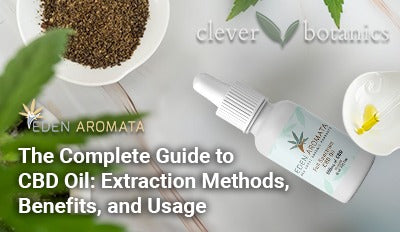Indica vs Sativa: What's the Difference?
Sativa and Indica are two distinct types of Cannabis plants, and their CBD flowers exhibit different characteristics. CBD (cannabidiol) is a non-psychoactive compound found in both Sativa and Indica plants. The differences between Sativa and Indica CBD flowers mainly lie in the plant’s growth patterns, appearance, and effects on the user.
Sativa CBD flowers:
- Growth pattern: Sativa plants are taller and have longer, narrower leaves. They tend to grow well in warmer climates with longer periods of sunlight.
- Appearance: Sativa flowers are typically longer and less dense compared to Indica flowers.
- Effects: Although CBD itself doesn't cause a "high," Sativa CBD flowers are known to produce more uplifting and energizing effects. They are often recommended for daytime use or when an individual seeks to increase focus and creativity.

Indica CBD flowers:
- Growth pattern: Indica plants are shorter and bushier, with broader leaves. They usually grow well in cooler climates and have a shorter flowering period than Sativa plants.
- Appearance: Indica flowers are denser, more compact, and often more resinous than Sativa flowers.
- Effects: Indica CBD flowers tend to have more relaxing and calming effects. They are commonly recommended for night-time use or for individuals dealing with anxiety, stress, or sleep disorders.
- Traditionally, Indica plants contained higher amounts of CBD than THC, while Sativa plants typically have higher amounts of THC than CBD. Indica is believed to cause more of a calming or relaxing effect, while Sativa is known to cause an uplifting feeling. However, to bring the THC levels down and make them legal, a lot of work needed to be done, including crossing different strains with industrial-grade CBD strains which produce hybrids with dominance towards Indica or Sativa.
- Sativas are known for their “head high,” an invigorating effect that can help reduce anxiety or stress and increase creativity and focus. Indicas are typically associated with full-body effects, such as increasing deep relaxation and reducing insomnia.
It's important to note that hybrid strains, which combine characteristics of both Sativa and Indica plants, are also available. These hybrid CBD flowers may exhibit a mix of the effects and growth patterns mentioned above. As the CBD market continues to evolve, you'll find many different strains with varying levels of CBD and other cannabinoids, so it's essential to research and find the strain that best suits your needs.

How do farmers reduce THC levels in Cannabis plants?
Reducing THC levels in cannabis plants involves careful selection of genetics, growing conditions, and cultivation practices. While it's challenging to completely eliminate THC from cannabis plants, one can minimize its concentration. Here are some strategies to reduce THC levels:
- Choose low-THC genetics: Start by selecting strains with naturally low THC levels. Certain strains, such as hemp or specific CBD-rich varieties, have been bred to contain minimal THC concentrations. Look for reputable seed banks and breeders that offer low-THC strains.
- Monitor plant stress: Environmental stress can cause cannabis plants to produce more THC. Ensure that your plants receive the appropriate amount of light, water, and nutrients to minimize stress. Avoid over-watering, under-watering, or exposing plants to extreme temperatures. Also, protect them from pests and diseases.
- Harvest at the right time: The THC content in cannabis plants tends to increase as they mature. Harvesting plants slightly earlier than their peak maturity can help reduce THC levels. However, be cautious not to harvest too early, as this may impact the overall yield and quality of your crop.
- Regular testing: Regularly test your plants for THC levels using a reliable testing method, such as high-performance liquid chromatography (HPLC). This will help you monitor the plants' THC content throughout their growth cycle and make informed decisions about when to harvest.
- Cross-breeding: If you have experience in breeding, you can try cross-breeding low-THC strains with other low-THC or high-CBD strains to further reduce THC levels. This process requires skill and patience, as it may take several generations of breeding to achieve the desired results.
- Legal compliance: In many jurisdictions, there are legal limits on the amount of THC that cannabis plants can contain, especially for hemp plants. Ensure that you follow the rules and regulations in your area to avoid potential legal issues. In the UK, it is generally accepted to keep the THC content to less than 0.2%.
It's important to note that these methods can only reduce THC levels to a certain extent. If one wants to ensure that the cannabis plants are as low in THC as possible, the grower must start with certified low-THC genetics and maintain optimal growing conditions.
Hybrid, high-entourage CBD hemp
A hybrid high-entourage CBD hemp refers to a cannabis plant bred to exhibit specific characteristics by combining the genetics of different parent plants. In this case, the hybrid is designed to have a high entourage effect with a focus on CBD (cannabidiol) content.
The entourage effect is a concept in cannabis science that suggests that the various compounds in the cannabis plant, including cannabinoids (like CBD and THC), terpenes, and flavonoids, work synergistically to provide a more significant therapeutic effect than any single compound alone. This means that the combination of these compounds can enhance the overall benefits of the plant.
A high-entourage CBD hemp plant would contain a rich profile of cannabinoids, terpenes, and other compounds that contribute to the entourage effect, while also having a high concentration of CBD. Such a plant may be bred for specific medicinal or therapeutic purposes, such as reducing inflammation, anxiety, or pain. Keep in mind that hemp plants, by definition, have low THC (tetrahydrocannabinol) content (<0.3%), so the focus would be on the non-psychoactive benefits of CBD and other compounds in the plant.








